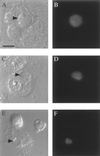Growth and development of tetracycline-resistant Chlamydia suis
- PMID: 11451674
- PMCID: PMC90631
- DOI: 10.1128/AAC.45.8.2198-2203.2001
Growth and development of tetracycline-resistant Chlamydia suis
Abstract
Tetracycline (TET) is a front-line antibiotic for the treatment of chlamydial infections in both humans and animals, and the emergence of TET-resistant (Tet(r)) Chlamydia is of significant clinical importance. Recently, several Tet(r) chlamydial strains have been isolated from swine (Sus scrofa) raised in production facilities in Nebraska. Here, the intracellular development of two Tet(r) strains, R19 and R27, is characterized through the use of tissue culture and immunofluorescence. The strains grow in concentrations of up to 4 microg of TET/ml, while a TET-sensitive (Tet(s)) swine strain (S45) and a strain of the human serovar L2 (LGV-434) grow in up to 0.1 microg of TET/ml. Although inclusions form in the presence of TET, many contain large aberrant reticulate bodies (RBs) that do not differentiate into infectious elementary bodies. The percentage of inclusions containing typical developmental forms decreases with increasing TET concentrations, and at 3 microg of TET/ml 100% of inclusions contain aberrant RBs. However, upon removal of TET the aberrant RBs revert to typical RBs, and a productive developmental cycle ensues. In addition, inclusions were found that contained both C. suis R19 and Chlamydia trachomatis L2 after sequential infection, demonstrating that two biologically distinct chlamydial strains could both develop within a single inclusion.
Figures







Similar articles
-
Horizontal transfer of tetracycline resistance among Chlamydia spp. in vitro.Antimicrob Agents Chemother. 2009 Nov;53(11):4604-11. doi: 10.1128/AAC.00477-09. Epub 2009 Aug 17. Antimicrob Agents Chemother. 2009. PMID: 19687238 Free PMC article.
-
Effects of sustained antibiotic bactericidal treatment on Chlamydia trachomatis-infected epithelial-like cells (HeLa) and monocyte-like cells (THP-1 and U-937).Int J Antimicrob Agents. 2006 Apr;27(4):316-24. doi: 10.1016/j.ijantimicag.2005.11.010. Epub 2006 Mar 9. Int J Antimicrob Agents. 2006. PMID: 16527461
-
Tetracycline Susceptibility in Chlamydia suis Pig Isolates.PLoS One. 2016 Feb 25;11(2):e0149914. doi: 10.1371/journal.pone.0149914. eCollection 2016. PLoS One. 2016. PMID: 26913523 Free PMC article.
-
The intracellular life of chlamydiae.Semin Pediatr Infect Dis. 2002 Oct;13(4):239-48. doi: 10.1053/spid.2002.127201. Semin Pediatr Infect Dis. 2002. PMID: 12491229 Review.
-
Chlamydial Antibiotic Resistance and Treatment Failure in Veterinary and Human Medicine.Curr Clin Microbiol Rep. 2016;3:10-18. doi: 10.1007/s40588-016-0028-4. Epub 2016 Feb 3. Curr Clin Microbiol Rep. 2016. PMID: 27218014 Free PMC article. Review.
Cited by
-
Generation of Tetracycline and Rifamycin Resistant Chlamydia Suis Recombinants.Front Microbiol. 2021 Jun 30;12:630293. doi: 10.3389/fmicb.2021.630293. eCollection 2021. Front Microbiol. 2021. PMID: 34276577 Free PMC article.
-
Phenotypic and Genotypic Antimicrobial Susceptibility Testing of Chlamydia trachomatis Isolates from Patients with Persistent or Clinical Treatment Failure in Spain.Antibiotics (Basel). 2023 May 28;12(6):975. doi: 10.3390/antibiotics12060975. Antibiotics (Basel). 2023. PMID: 37370294 Free PMC article.
-
Productive and Penicillin-Stressed Chlamydia pecorum Infection Induces Nuclear Factor Kappa B Activation and Interleukin-6 Secretion In Vitro.Front Cell Infect Microbiol. 2017 May 11;7:180. doi: 10.3389/fcimb.2017.00180. eCollection 2017. Front Cell Infect Microbiol. 2017. PMID: 28553623 Free PMC article.
-
An automated image-based method for rapid analysis of Chlamydia infection as a tool for screening antichlamydial agents.Antimicrob Agents Chemother. 2012 Aug;56(8):4184-8. doi: 10.1128/AAC.00427-12. Epub 2012 May 21. Antimicrob Agents Chemother. 2012. PMID: 22615279 Free PMC article.
-
Prevention strategies for sexually transmitted infections, HIV, and viral hepatitis in Europe.Lancet Reg Health Eur. 2023 Oct 26;34:100738. doi: 10.1016/j.lanepe.2023.100738. eCollection 2023 Nov. Lancet Reg Health Eur. 2023. PMID: 37927439 Free PMC article. Review.
References
-
- Andersen A A, Rogers D G. Resistance to tetracycline and sulfadiazine in swine C. trachomatis isolates. In: Stephens R S, et al., editors. Chlamydial Infections. Proceedings of the Ninth International Symposium on Human Chlamydial Infection. 1998. pp. 313–316.
-
- Anonymous. Government advisory committee calls for a reduction in antibiotic use. Vet Rec. 1999;145:266–267. - PubMed
-
- Bannantine J P, Griffiths R S, Viratyosin W, Brown W J, Rockey D D. A secondary structure motif predictive of protein localization to the chlamydial inclusion membrane. Cell Microbiol. 2000;2:35–47. - PubMed
-
- Barth W F, Segal K. Reactive arthritis (Reiter's syndrome) Am Fam Physician. 1999;60:499–503. - PubMed
Publication types
MeSH terms
Substances
LinkOut - more resources
Full Text Sources

